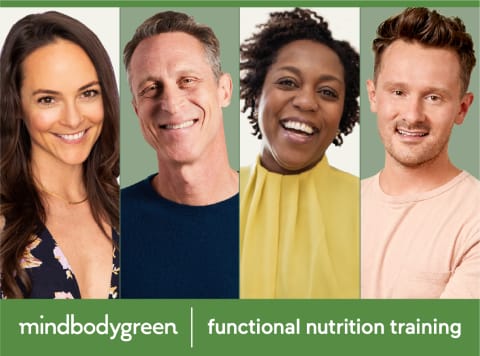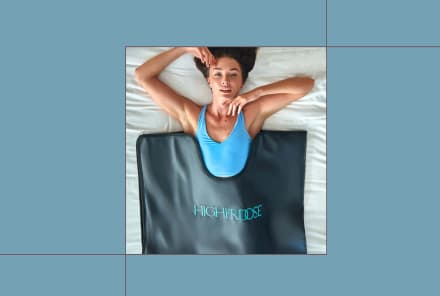Advertisement
5 Ways I Completely Transformed My Approach To Well-Being, To Help Clients Reach Their Goals


Years ago, I was working with a lab company that offered food sensitivity testing. I was teaching doctors about how to use this testing in their practice so that they could help their patients feel better faster, by determining their food intolerances.
Many of these patients complained about symptoms like headaches, joint pain, fatigue, skin problems, gas, and bloating. These problems pointed to potential food sensitivities, so the doctors would run the lab test to reveal which foods weren't working for them.
A few months in, after looking at a lot of tests, it seemed that the majority of the patients were reacting to the same few foods. Since the lab test results took a few weeks to get back, I decided to pull the most likely suspects while they were waiting for the test results.
They would return for their results with dramatic changes in a matter of weeks: improved digestion, reduced joint pain, better energy, and more. I realized that for a large part of the population, it was more effective, cheaper, and faster to do this modified elimination diet than to do the traditional lab testing. We only needed testing for the outliers.
That revelation became the basis for my first New York Times bestseller, The Virgin Diet. To some people, it seemed like that book came out of nowhere and I was an overnight success, but the reality is that success was decades in the making. Let me share the five key strategies I discovered along the way, which helped transform my approach to wellness:
Narrow your niche.
You can't fix everything. Or as we say: "jack of all trades, master of none." Right from the beginning, decide which problem you want to focus on. Another way to think about it: What are your clients or patients coming to you for? Really home in on that and narrow the niche.
Package that problem as a transformation, where you show your clients a way to break free and feel better. That transformation might be: I help people identify what causes this post-meal misery…and I offer solutions like eliminating food intolerances and healing their gut, which allows them to enjoy food without worrying or suffering.
Create your community.
To help your clients successfully reach that transformation, you need to know who you're serving. That means really dialing in your demographics, including easy things like their age group and gender. Be sure to dive deep into their psychographics, too. Ask yourself: What do these people care about, who do they pay attention to, and how do they spend their time and money?
Just like you can't fix everything, you can't be all things to all people. You have a particular problem to solve and a unique clientele who you solve it for. Center in on that audience and find out where they're hanging out.
I would ask myself again and again: Who are these people? The ones who are dedicated and determined to heal these issues. And then, which predominant platform do these people hang out on? That's where you want to spend time. Observe what others are doing.
Eventually, I found that I really enjoyed helping women 40 and above who were heading into menopause. I understood these women. I knew their aspirations, their frustration and pain, and the challenges that they confront daily.
Focus your messaging.
Building your audience requires speaking in their language. What makes them tick? Remember, you want to speak in terms of what they say, not what you say. Pay attention to how your audience communicates.
Ultimately, you want these people to say, "Wow, she really gets me." You want them to feel seen and heard. That's the end result when they read your messaging.
Your message helps clearly communicate the process you take them through. It should be consistent and compatible with who you're serving. Again, pay attention to what others are saying in your field. Really spend time getting to know your audience. Consider hiring a writer who can capture and expand your voice.
Package your services.
You've found your problem, your audience, and your messaging. The next step is to offer your services, which includes determining the prices you want to charge. You have several ways to do that, including per-session or package/program prices.
If you've ever worked with a one-on-one client, you're probably familiar with the challenge of getting them to stay committed. We have a saying: If you offer "pay as they go, they go." When they've purchased a program or package, you don't have to resell them to come back every time. This is critical because people don't get better overnight.
You can't possibly cover everything they need with one session. That's why you want to package your offer into programs. Getting your client to commit requires time and money. You might offer one to three package options so you can help them choose what fits with their goals.
Continue to learn and grow.
Even a few years ago, I wasn't a fan of intermittent fasting. I believed that everyone did well having a protein-packed smoothie or other nutrient-rich breakfast within an hour of waking up.
But science changed my mind. I was seeing more and more studies showing the so many great benefits of intermittent fasting, including longevity, immune support, and blood sugar balance.
So I modified my approach. I kept breakfast, but I asked people to push their first meal of the day forward to, say, 9 or 10 a.m., which made it easy to do a 14- to 16-hour overnight fast. On the weekends this could turn into an 11 a.m. brunch and an early dinner for a shorter eating window.
Had I stuck with my original idea, I would have deprived clients of what we're now seeing with the many, many benefits of fasting. To help clients successfully reach their goals, you always want to keep a beginner's mind. Science continues to evolve—so should you.
Evolving in your wellness approach might mean hiring a coach, joining a mastermind of like-minded folks, or taking continuing education courses to develop your knowledge.
When you stay on top of the latest research, your expertise grows. And you up-level the success of your clients along the way. Otherwise, you stagnate and shrink. And that's no way to grow or help your clients succeed.
One final point.
The five strategies I've discussed don't occur overnight, nor are they linear. This is why being in a like-minded community and continuing to learn is so important. Don't be afraid to experiment. You will occasionally misstep, but that's part of the learning process. The ability to serve and make a bigger impact makes that process entirely worth it.
Watch Next
Enjoy some of our favorite clips from classes
Enjoy some of our favorite clips from classes
What Is Meditation?
Mindfulness/Spirituality | Light Watkins
Box Breathing
Mindfulness/Spirituality | Gwen Dittmar
What Breathwork Can Address
Mindfulness/Spirituality | Gwen Dittmar
The 8 Limbs of Yoga - What is Asana?
Yoga | Caley Alyssa
Two Standing Postures to Open Up Tight Hips
Yoga | Caley Alyssa
How Plants Can Optimize Athletic Performance
Nutrition | Rich Roll
What to Eat Before a Workout
Nutrition | Rich Roll
How Ayurveda Helps Us Navigate Modern Life
Nutrition | Sahara Rose
Messages About Love & Relationships
Love & Relationships | Esther Perel
Love Languages
Love & Relationships | Esther Perel
What Is Meditation?
Box Breathing
What Breathwork Can Address
The 8 Limbs of Yoga - What is Asana?
Two Standing Postures to Open Up Tight Hips
How Plants Can Optimize Athletic Performance
What to Eat Before a Workout
How Ayurveda Helps Us Navigate Modern Life
Messages About Love & Relationships
Love Languages
Advertisement

This Little-Known Supplement Helps Women Sleep & Decreases Signs Of Depression
Molly Knudsen, M.S., RDN

This Little-Known Supplement Helps Women Sleep & Decreases Signs Of Depression
Molly Knudsen, M.S., RDN
















